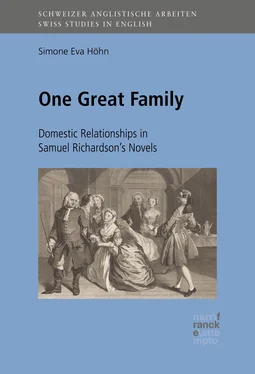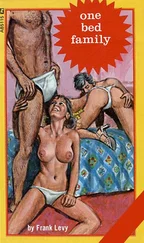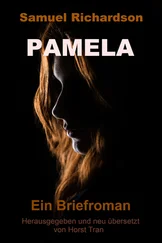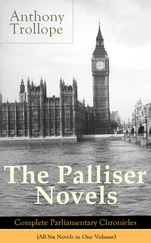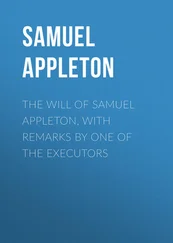There is, however, another and even graver danger: that masquerade is only a guise for what is, in fact, one’s reprehensible essence. When Harriet is drawn into a description of masquerades some time after her abduction, she seems at first preoccupied with the folly of the ‘diversion’. Masquerade is likened to “Bedlam” (1:426), and her own “tinsel dress” is “ridiculous”. Ashamed of herself, Harriet considers what her
good grandfather [would] have thought, could he have seen his Harriet, the girl whose mind he took pains to form and enlarge, mingling in a habit so preposterously rich and gaudy, with a croud of Satyrs, Harlequins, Scaramouches, Fauns, and Dryads; nay, of Witches and Devils; the graver habits striving which should most disgrace the characters they assumed, and every one endeavouring to be thought the direct contrary of what they appeared to be. (1:427)
At the beginning of Harriet’s account, outside and inside are out of tune; the problem is that the dress belies the well-regulated mind. As she goes on, the correspondence between habit and “habits” becomes increasingly blurred. If “every one” endeavours “to be thought the direct contrary of what they appeared to be”, how comes it that “the Devils, at least”, were not “charming creatures”, as Charlotte Grandison jokingly suggests (1:427)? The reason is that masquerade is not a simple reversal of truth. Rather, it offers scope for a variety of relations between truth and false appearance – for the (in Harriet’s account) grotesque spectacle of an “enlarged mind” in a “tinsel dress” and “graver habits striving to disgrace the characters they assumed”, as well as for appearances that display the mind. Harlequins openly declare their folly, and devils display their want of principles. The fact that their behaviour is so unpredictable only makes it the more sinister: do they endeavour to be thought the contrary of what their character in the real world is, or, rather, of what their masquerade habit would seem to demand? And if they appear “charming”, does this belie the ‘truth’ of their dress or rather confirm them as seductive Satans?
Masquerade, then, highlights the deceitfulness of appearance even while giving scope to its exploitation. It is the emblem in negative of Harriet’s own behaviour; she strives to attain that absolute frankness which she will not acknowledge to be unattainable. Something of this indeterminacy is shown also in Mr. B.’s flirtation at the masquerade, where both he and the Countess Dowager dangerously play with a variety of relations to ‘truth’. As Pamela angrily notes, they do not act up to their costume; as a Spanish Don, “the dear Gentleman no more kept to his Spanish Gravity, than she to the Requisites of the [Nun’s] Habit she wore: When I had imagin’d, that all that was tolerable in a Masquerade, was the acting up to the Characters each Person assum’d” ( Pamela in her Exalted Condition 365). He should act more proudly and seriously, she more modestly, than they do. On another level, however, their “habits” do indeed express their characters: Mr. B. does have pride, and the Countess is more virtuous than Pamela fears. In consequence of their imprudent behaviour, rumours of adultery arise; these are wildly exaggerated and yet partly justified, since the behaviour of B. and the Countess affronts propriety. The masquerade is so horrible precisely because it allows essentially virtuous people to play with fire, instead of restricting all behaviour to that which is proper.
Nevertheless, some Richardsonian characters can envisage ways to counteract the negative effects of masquerade by fixing its relation to truth. One such proposition is Caroline L.’s suggestion that masquerade could be “a rational and almost instructive entertainment” if only decent characters were assumed and then “support[ed] with wit and spirit” (1:427; cf. also Pamela in her Exalted Condition 368). Sir Charles rejects her proposal by arguing not only that few people are able to fulfil the prerequisites of “wit” and “decorum”, but that the example of the select few would reach down to those who would copy masquerade in a degenerated, riotous form. In other words, innocuous versions of the play with truth and appearance may indeed be imagined, but to act on this is to encourage deceit.
However, role play is not condemned so thoroughly in all of Richardson’s fiction. Indeed, Pamela – despite its condemnation of masquerade – includes and endorses various kinds of ‘masquerade’. Both the original novel and its continuation include various scenes of disguise which can be either beneficial or problematic; indeed, it is often a matter of interpretation as to what functions as ‘disguise’ and what does not – Pamela’s appearance in rustic dress is presented by her as acting up to her true identity, while Mr. B. interprets it as a ploy to catch his attention ( Pamela 57).2 In Pamela in her Exalted Condition , the heroine condemns the disguises employed in the stage comedy The Tender Husband . In the play, almost all the characters cheat each other, using lies and cross-dressing to achieve their purposes, which are utterly selfish (355–61). However, both Pamela and her husband also employ disguise for justifiable ends. Thus, Pamela – at the behest of her friends – acts the part of “Lady Jenny” in front of her husband’s uncle, Sir Jacob Swynford, who has come to rebuke his nephew for marrying beneath him. By pretending to be the well-born Lady Jenny, daughter of the Countess of C., low-born Pamela has the chance to demonstrate her worth. The trick succeeds, and Sir Jacob is reconciled: “Who can chuse but bless you?” (217). What distinguishes the ‘masquerade’ staged for Sir Jacob from the deceits practiced in The Tender Husband is the different motivation of the actors. Mr. B.’s uncle is deceived so that he can see the truth.3
Role-play, albeit not actual masquerade, is discussed in even more light-hearted terms in Richardson’s Familiar Letters Richardson, Samuel Familiar Letters on Important Occasions on Important Occasions . In letter LXXXV, a gentleman rebukes a lady for her “supposed Coquetry” (108) only to be reprimanded in turn:
Perhaps I like to see the young fellows dying for me; but since they can do it without impairing their health, don’t be so very angry at me. In short, sir, you are your own master; and, Heaven be thank’d, I am, at present, my own mistress; and your well-manner’d letter will make me resolve to be so longer than perhaps I had otherwise resolved. (109)
The lady’s answer reminds suitor and reader alike that her own coquetry, like “the young fellows dying ”, are part of an elaborate code of behaviour known to all parties, who are able to support their parts with the wit and decorum stipulated by Caroline. Clearly, decorum – specifically with regard to courtship – involves its own kind of masquerade; indeed, Clarissa’s friend Miss Biddulph claims that female “coquetry” is only the natural consequence of men’s “false hearts” (44). When Harriet prepares for her masquerade, she tries to echo the attitude of the anonymous lady who “likes to see young fellows dying for her”. Though she feels uncomfortable in her dress from the first, she attempts to support her character of “Arcadian Princess” with spirit (1:115). As she ends her letter to her cousin Lucy, she asks her to imagine “how many Pretty-fellows […] in this dress, will be slain by [Harriet]” (1:116). Her playful assumption of coquetry comes back to haunt her when she later remembers that this was the last line she wrote before her abduction (1:150). As she recognises at the masquerade, dress and situation cannot be kept separate from behaviour, and perhaps not even from character: “No prude could come, or if she came, could be a prude, there” (1:427).4
Читать дальше
